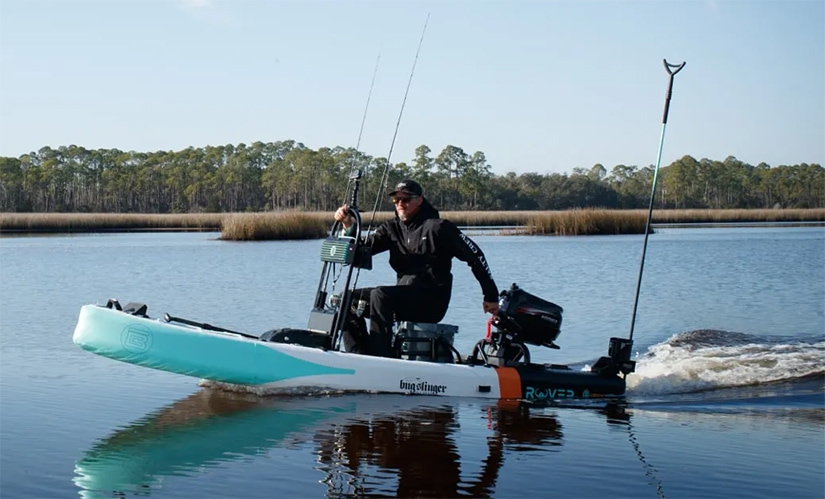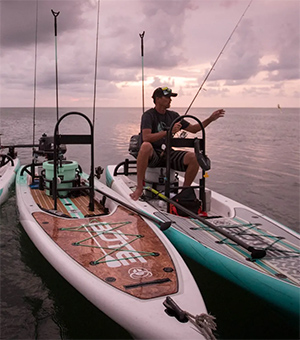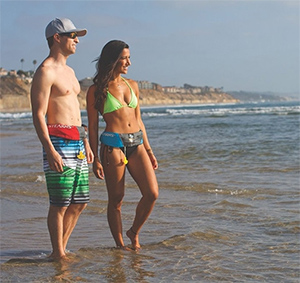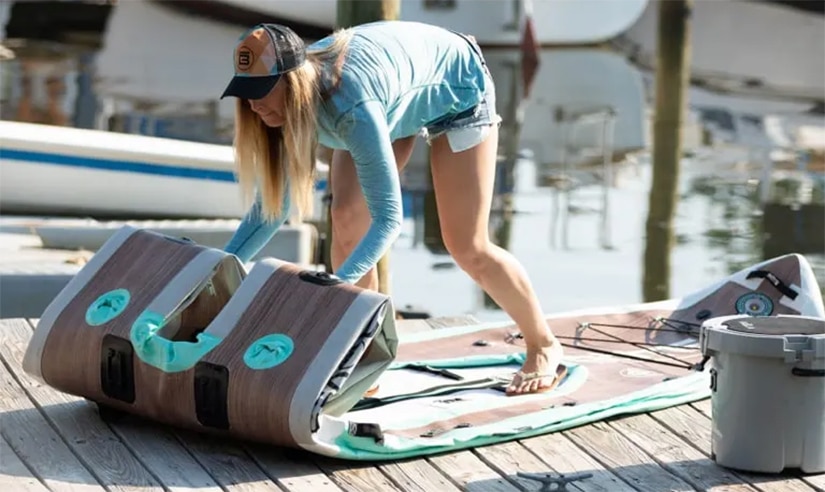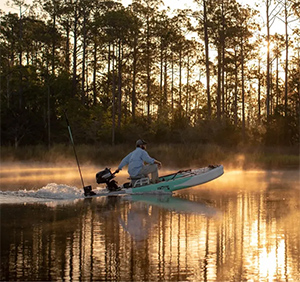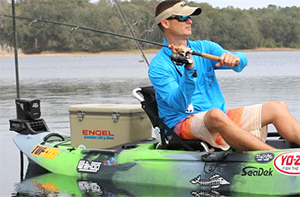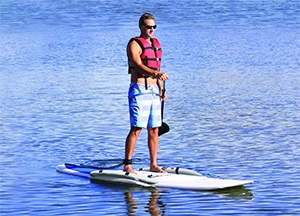You’ve probably heard all about SUP fishing and have decided you don’t want to be left behind. Welcome to the club! Fishing from your paddle board is now a thing and anglers love it.
Why wouldn’t they? It comes with tons of benefits.
If you fish from a paddle board, you can get into fishing spaces that are too tight for bigger vessels. The standing position gives you a fantastic view of the water and SUPs are small and portable.
Plus, paddle board fishing provides a full body workout – so you can catch dinner and exercise at the same time.
If you’re curious to learn more about paddle board fishing, then you’ve come to the right place!
Key Takeaways
- Get a good fishing SUP that’s long and wide, with a high weight capacity. The large platform helps with stability and allows you to bring a lot of gear.
- Plan your SUP fishing trip beforehand; take into account the weather and water conditions.
- Bring an anchor to keep your board in place while fishing and a SUP cooler for your refreshments. It can also double as a seat.
- Vertical rod holders will keep your fishing rods secure and easily accessible while a paddle holder will free your hands for fishing.
- Don’t forget your safety gear!
15 Tips for Stand Up Paddle Board Fishing
Paddle board fishing is pretty accessible – if you’re already familiar with stand up paddle boarding then you can make the transition to SUP fishing. But, it’s definitely advisable to do a little bit of research first. Here are some useful paddle board fishing tips to help you get started.
1. Choose the Right Paddle Board
Stand up paddle boards come in different shapes and sizes. SUP racing boards, for instance, are long and narrow with a displacement hull. This is meant to help them glide fast and smoothly.
Stand up fishing paddle boards are long and wide, with a high weight capacity. The large platform helps with stability and allows you to bring a lot of gear.
All fishing boards are not the same size and they differ when it comes to design.
There are inflatable as well as epoxy fishing paddle boards. An inflatable SUP is easy to store and transport, without the need of a roof rack or a truck. A hard traditional board performs slightly better and you won’t have to carry a pump on your trip. Therefore, it’s up to you to decide which type of board and its benefits are more suited to you.
The other thing you should consider is the size of the board. Before you choose the biggest fishing SUP, consider storage and transport. Large paddle boards have more stability and will hold more gear, but they can be bulky (especially solid boards) so you want to consider how you will store and transport the board.
Lastly, check the attachment points and weight capacity. You want a board that allows you to customize and bring all the gear you need.
This means enough D-rings and gear mounts. Some SUPs, like the Bote Rover fishing paddle boards, even come with a motor rack so you can add a motor.
2. Know Your SUP Board
Spend some time paddling your new stand up paddle board. See how it feels, how responsive it is—get familiar with it. This is even more important if you’re a newbie.
Knowing your SUP board and how it performs gives you confidence. It also makes it easy for you to handle different situations while on the water.
You can add your fishing gear and paddle around as a practice run, so you know how it will feel on an actual fishing trip. Try casting too and see if the SUP board is stable enough.
3. You Will Need an Anchor
Imagine trying to catch fish while your paddle board is drifting away. That sounds frustrating, doesn’t it?
Fortunately, you can get a SUP anchor. Once you find a nice fishing spot, anchor the board and take all the time you need.
Paddle board anchors are small, lightweight, and easy to use. It won’t take up a lot of space on your SUP.
4. Bring a SUP Cooler
A SUP cooler is a must-have for standup paddleboard fishing. It serves several purposes.
First, it keeps your drinks cool. Few things are worse than having to drink warm water when it’s hot and you’ve been out fishing the whole day. A paddle board cooler ensures that you have a nice cool drink to quench your thirst all day long. Plus, if you’re not planning on catching and releasing, it’s also where you will store your fish.
In addition to storage, the cooler acts as a seat. Unlike fishing kayaks, fishing SUP boards don’t have a place for you to sit. With a SUP cooler, you can alternate sitting and standing so you don’t get too tired.
5. Pick a Spot That Is Accessible by SUP
SUP fishing boards are small and offer easy access to places that may be inaccessible by a boat or kayak. But some spots can be tricky even with a paddle board.
For instance, you want to avoid shallow water because you can easily damage your fin. The fins can also get tangled up by vegetation. In such a situation, you will have to get off the SUP and drag it out.
ALSO READ: Paddleboard Vs Kayak Fishing – Which Is Better?
6. Wear the Right Clothes for Your Fishing Trip
What you wear depends mainly on the weather.
When it is hot, you can wear what you typically wear during any other fishing trip. Remember to bring your sun hat and polarized sunglasses.
If you are going SUP fishing in cold weather, a wet suit is better suited.
7. Don’t Forget Your Safety Accessories
Stand up paddle board fishing is not a dangerous activity but the water can be unpredictable.
Wear your SUP board leash at all times. The leash keeps you attached to your paddle board. If you fall in, you will be able to get back on in no time. Without a leash, the standup paddle board can quickly drift away, leaving you stranded.
You should also wear your life jacket. In addition to keeping you afloat, fishing life vests have extra storage for other accessories.
Bring a cell phone, whistle, basic first aid kit, marine radio, and a compass too.
8. Always Check the Weather and Water Conditions
It is a good idea to plan your SUP fishing trip beforehand; take into account the weather and water conditions and consider all factors including tides, the wind, and current.
Paddle board fishing is a thrilling activity and it is easy to get carried away. Always remember that the conditions can change in a short moment. Don’t get so caught up trying to spot fish that you forget to pay attention to what’s happening.
9. Have a Plan for Getting In and Out of the Water
While planning, remember to choose an entry and exit point, then survey the areas. Look out for rocks, oyster bars, and sandbars that can easily damage your fin and board.
We’ve mentioned that the conditions can be unpredictable so you can never be too prepared.
10. Carry Minimal Gear
One common mistake that beginner SUP anglers make is carrying too much stuff. You get the most expensive gear and set off, expecting to catch big fish and have the best experience.
Your first few trips should be more about learning how to cast from a paddle board.
SUP fishing doesn’t have a steep learning curve. But with a standup paddleboard full of gear, you might have a hard time and balancing will be trickier.
Besides, you don’t even have that much space on a SUP board and it is easy to lose your stuff. Can you imagine how painful it would be to have your fancy fishing rods lying somewhere at the bottom of a lake?
Only bring the bare essentials and see how it goes. Try going with a fishing rod, small cooler, tackle bag, cast net, and anything else you’re sure you’ll need. .
You can add more fishing gear with time.
11. Keep Your First SUP Fishing Trip Short
As mentioned, the first few paddle board fishing trips are more about learning. You don’t even have to find fish.
So don’t get ahead of yourself during your first trip.
Paddling is fun but it is not as easy as it looks. Remember we said it is a full-body workout. Every muscle will be engaged.
You have to paddle to your destination. Once you get there, you will want to fish and then paddle back. It can be a lot of work.
Don’t overestimate how much you can paddle. Keep the trip short so you will have enough energy to paddle back and get home safely.
12. Vertical Rod Holders Will Make Your Work Easier
There are several ways to store your rods while SUP fishing. Some boards even have storage holes for your fishing rods in the deck.
But unlike kayak fishing, SUP fishing involves a lot of standing. You want your fishing rods to be secure and easily accessible at the same time.
If your fishing rod is lying on the deck, you will have to bend and get it every time you need it. This is why you should consider vertical rod holders.
Some fishing standup paddle boards come with gear mounts for you to attach your rod holders vertically.
Another alternative would be to get a SUP cooler box with a rod holder on either side.
13. Get a Paddle Holder
Where should you put your paddle when SUP board fishing?
Just like your fishing gear, paddles are not cheap. You will want to keep it safe, especially if you went all out and got a carbon paddle. You also need to paddle back home so it is a matter of personal safety.
Some SUP boards have a paddle holder, which gives you a place to store your paddle while fishing. It is usually on the side of the board.
If yours didn’t come with one, you can always get an aftermarket paddle holder or paddle leash on Amazon. They are inexpensive and easy to use.
Unfortunately, vertical paddle holders aren’t as common as vertical rod holders. You will be forced to bend every time you want to secure it or pick it up to continue paddling.
Does this sound like too much work? We’ve seen fishing SUP boards that save you the trouble by including a paddle sheath at the bow. The Bote Rover is a good example. It allows you to store the paddle vertically for quick access.
14. Stabilizers Help with SUP Stability
SUP stabilizers are a great option for the angler who wants extra stability.
Maintaining balance on a stand up paddle board can be tricky for newbies. If you add fishing, which involves a lot of movement, it becomes even more challenging.
You may need stabilizers if your board is a little on the narrow side, if you are bigger, or if you just want to be more confident.
Stabilizers will also come in handy when the water gets rough.
15. Have Fun!
Stand up paddle board fishing has very few limitations. You can do inshore fishing, offshore fishing and be as adventurous as you’d like.
So have fun and feel free to explore.
Wrapping Up
YOU MAY ALSO LIKE: 20 Paddle Board Fishing Gifts Ideas For Your Favorite Fisher(wo)man.
SUP fishing is fantastic for anyone looking for an active fishing experience.
Hopefully, the above SUP fishing tips will help you stay safe and have a wonderful time.
Get the right board, a good paddle, safety accessories, and proper fishing gear. Remember to plan beforehand so you avoid any unpleasant surprises.
Don’t bring too much stuff, keep the first few trips short, and lastly, enjoy yourself!
Do you have any questions about standup paddleboard fishing? Feel free to ask us below.
Happy paddling!

